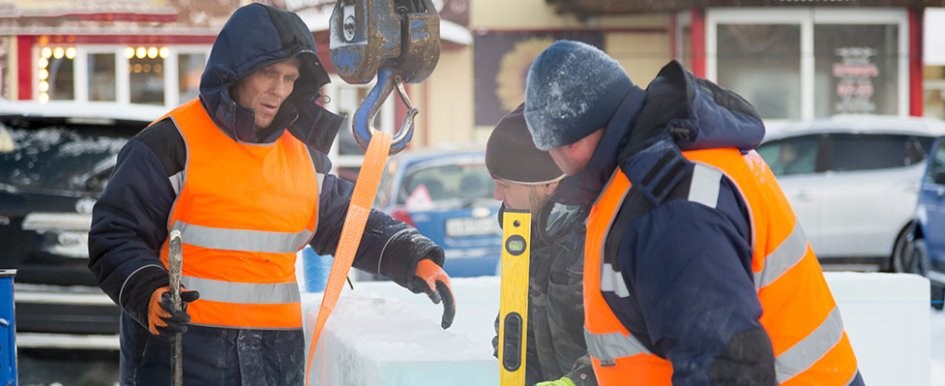
Hand injuries accounted for 102,350 days away from work in 2020, according to the Bureau of Labor Statistics and the National Safety Council. Even minor scrapes and lacerations can prevent construction laborers from completing their work, leading to significant delays and costly medical care. The winter months only increase the risk of hand injury in the construction industry.
Since many workers use their hands to grip tools and operate potentially dangerous equipment, construction business owners must prepare their crews for winter by helping them select and maintain their personal protective equipment (PPE). Although the Occupational Safety and Health Administration (OSHA) doesn’t require business owners to supply clothing to protect against the cold, they must provide a safe work environment for all personnel to ensure everyone uses the proper gear.
Not all pairs of gloves are alike. The material should be suited for the specific application. Some situations can be too dangerous for the staff to work outdoors. Crews of all sizes can use this guide to stock up on winter construction gloves.
Winter Work Gloves
Winter construction gloves are made to withstand the dangers of working around sharp objects, moving parts and other environmental hazards, with thermal layering to insulate the person’s hands.
Traditional gloves may not keep the cold at bay, leading to frostbite, loss of feeling and potential tissue damage. Some materials will stiffen in the cold, limiting the worker’s range of movement. The staff should have full use of their hands as they go about their job.
The outermost layer must be waterproof to keep the person’s hands dry. Moisture can increase the risk of frostbite. Acrylic and latex gloves are just as flexible in frigid temperatures, helping workers move seamlessly in the field.
Water and cold air can slip through the cuffs of the gloves. The jacket sleeves should extend over the cuffs to create a proper seal while covering every inch of the person’s skin.
Choose the Right Size
The gloves will be most effective if they fit the person’s hands properly. If the gloves are too tight, they could restrict circulation or movement. Loose fabric can easily get caught in moving parts and machinery. The material must be flush against the person’s hands and wrists. Construction businesses should supply various sizes to accommodate all hand types.
Get a Grip
It’s essential to use gloves that help workers maintain a firm grip on tools and slick surfaces. Gloves with an HPT coating repel liquids for a firm grip. Many pairs come with a textured coating to increase traction and adhesion, making it easier for workers to interact with cold objects which leads to fewer drops and slips.
The crew can also use wrist, waist and anchored tethers as additional backup to keep equipment from falling.
Wash & Maintain
All gloves must be washed according to the manufacturer’s guidelines. Using the wrong detergent or setting can damage the gloves’ protective qualities. Workers should also inspect their gloves for rips, tears and weak spots before and after every shift. If the gloves appear damaged and cannot be repaired using the same fabric, they should be removed from use and replaced with a new pair.
Supplement the Gear
Workers can also use hand warmers if their hands feel cold. It’s easy for the staff to carry these packets around in the field. As soon as they’re exposed to oxygen, they heat up quickly to provide instant relief from the cold. Perfect to slip into pockets, these hand warmers can also be placed directly inside gloves or even under hard hats or helmets if workers need warmth near their heads.
If someone experiences a medical emergency, the crew should have access to heat packs, warm beverages and a climate-controlled space to increase their body temperature before their health deteriorates quickly.
Reduce the Risk
Business owners can also adjust their operations to reduce staff exposure to the elements by changing how and when they work. The most strenuous tasks should be done during the warmest part of the day.
Our bodies use more energy in the cold. Workers should have access to nourishing food to keep their energy up in the field. Snacks and warm beverages should be provided.
The cold won’t affect everyone equally. Individuals with preexisting health issues, including cardiovascular diseases, tend to be more susceptible to the cold, increasing their risk of injury.
Increase Visibility
Winter can also make it harder for the crew to see. Intense fog, rain, snow and sleet reduce visibility. Some might even have trouble seeing their hands right in front of them in storm and blizzard conditions. Workers can use high-visibility winter work gloves to see their hands so they don’t get caught in machinery with moving parts. The outer material is made with bright neon colors with reflective tape to stand out in dim conditions.
Know When It’s Too Cold
Every pair of work gloves should come with a workable temperature range. The material may freeze or stiffen in extreme weather, limiting worker mobility. Bring your team inside where it’s warm if the gloves aren’t designed to work in the current climate.
Everyone on-site should know the risks and warning signs of frostbite so they can speak up if they feel they are at risk. A loss of feeling, redness, tingling or burning sensations could quickly get out of control, leading to permanent injury.
Some situations aren’t suitable for work. If the crew feels unsafe or doesn’t have the gear they need, the operations should be rescheduled.
Working in construction in the winter can be tough on the staff. Every effort should be made to keep the crew safe and warm. If the task can’t be performed safely, it’s best to perform it when conditions improve. Proper hand protection reduces the risk of accidents and injuries so the company can do the job correctly without exposing the staff to harm.



